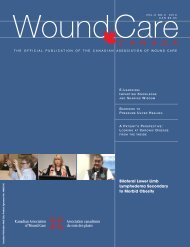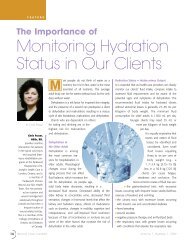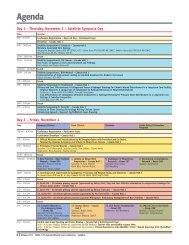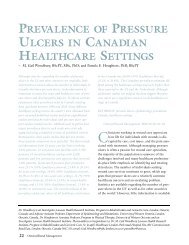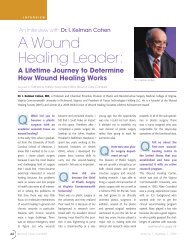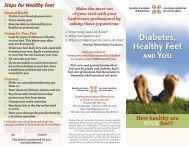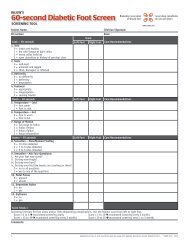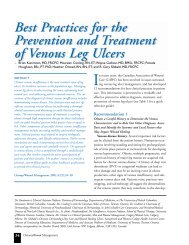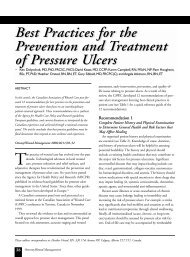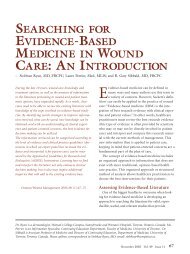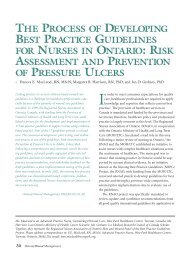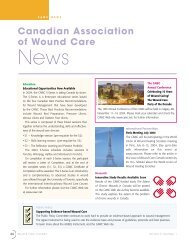Preparing the Wound Bed – Debridement, Bacterial Balance, and ...
Preparing the Wound Bed – Debridement, Bacterial Balance, and ...
Preparing the Wound Bed – Debridement, Bacterial Balance, and ...
Create successful ePaper yourself
Turn your PDF publications into a flip-book with our unique Google optimized e-Paper software.
important as a catalyst very early on in wound healing to<br />
promote cellular migration <strong>and</strong> collagen syn<strong>the</strong>sis. It is<br />
applied daily, <strong>and</strong> <strong>the</strong> study showed that with best clinical<br />
practices <strong>and</strong> Regranex ® , healing rate was increased by 15%<br />
in a 20-week trial from 35% in <strong>the</strong> control group to 50%<br />
having complete wound closure in diabetic neurotropic foot<br />
ulcers.<br />
Recent advances in tissue culture techniques (Reinwald<br />
<strong>and</strong> Green) 64 have made it possible to culture cells from<br />
human foreskin donors. Donated newborn foreskins are<br />
used to extract epidermal precursor cells <strong>and</strong> fibroblasts to<br />
master skin banks. Both cells <strong>and</strong> <strong>the</strong> mo<strong>the</strong>rs are extensively<br />
<strong>and</strong> repeatedly screened for possible infectious agents.<br />
From one piece of donated tissue, <strong>the</strong>se cells are transferred<br />
to working cell banks <strong>and</strong> can produce enough skin substitute<br />
to cover four to six football fields. Dermagraft <br />
(Advanced Tissue Sciences/Smith & Nephew Inc., La Jolla,<br />
Calif. <strong>and</strong> Largo, Fla.) is a human fibroblast-derived dermis<br />
consisting of bio-absorbable polygalactin mesh on which<br />
fibroblasts are seeded. The cells proliferate on <strong>the</strong> mesh in<br />
specialized bioreactors to form tissue that is cryopreserved<br />
<strong>and</strong> frozen for long-term storage.<br />
Dermagraft‚ in <strong>the</strong> <strong>the</strong>rapeutic range, increased <strong>the</strong> 12week<br />
healing of DNFU from 32% to 54% over best clinical<br />
practices. This difference in healing rate was maintained<br />
over <strong>the</strong> 32-week trial period demonstrating <strong>the</strong> potential<br />
long-term benefits of advanced <strong>the</strong>rapies. Apligraf ®<br />
(Organogenesis, Canton, Mass. <strong>and</strong> Novartis, East Hanover,<br />
NJ) consists of dermal fibroblasts <strong>and</strong> Type I bovine collagen<br />
matrix with an epidermis <strong>and</strong> differentiating stratum<br />
corneum. In a controlled trial, 63% of venous ulcers healed,<br />
compared with 48% of active control patients by week 24.<br />
A subanalysis of ulcers present for more than 1 year demonstrated<br />
complete healing of 47% of patients treated with<br />
Apligraf ®/ <strong>and</strong> compression compared to 19% treated with<br />
compression <strong>the</strong>rapy alone.<br />
Recently hyaluronic acid in a bipolymer has been made<br />
available for difficult to treat wounds. Hyaluronic acid is a<br />
major carbohydrate component of <strong>the</strong> extracellular matrix,<br />
inducing a prompt angiogenic response, promoting rapid<br />
formation of granulation tissue, assisting fibroblast growth<br />
<strong>and</strong> migration, <strong>and</strong> directing <strong>the</strong> organization of collagen<br />
disposition. 65 This agent has shown promise in case series,<br />
but no controlled trials have been published to date.<br />
Conclusion<br />
The wound care professional has an ever-exp<strong>and</strong>ing tool-<br />
box for ideal wound care. <strong>Debridement</strong>, bacterial balance,<br />
<strong>and</strong> moist interactive healing all must be optimized as integral<br />
parts of preparing <strong>the</strong> wound bed. If <strong>the</strong> underlying<br />
cause, patient-related factors, <strong>and</strong> <strong>the</strong> wound bed have all<br />
been appropriately treated, <strong>the</strong> new <strong>and</strong> exp<strong>and</strong>ing drawer<br />
of biologicals offers increased hope for some of our most difficult<br />
chronic wounds. - OWM<br />
Acknowledgment<br />
Some concepts presented in this paper were first developed<br />
through a series of articles by Diane Krasner <strong>and</strong> R.<br />
Gary Sibbald on wound care in Nursing Clinics of North<br />
America 27 ; Hyperbaric Medicine Practice, 2nd Edition 66 ; <strong>and</strong><br />
The Diabetic Foot, 6th Edition. 67 The local wound care paradigm<br />
(debridement, bacterial balance, <strong>and</strong> moisture balance)<br />
was presented by R. Gary Sibbald as part of a planning session<br />
at The Symposium on Advanced <strong>Wound</strong> Care <strong>and</strong><br />
Medical Research Forum on <strong>Wound</strong> Repair in Dallas, Texas,<br />
April 1<strong>–</strong>4, 2000. Concepts used in <strong>the</strong> charts have been<br />
modified from an educational retreat sponsored by an unrestricted<br />
educational grant from Smith & Nephew Canada<br />
<strong>and</strong> a 1998 Peel regional initiative <strong>and</strong> wound care guide,<br />
compiled by Caremark Ltd.<br />
References<br />
1. Lazarus GS, Cooper DM, Knighton DR, et al. Definitions<br />
<strong>and</strong> guidelines for assessment of wounds <strong>and</strong> evaluation of<br />
healing. Arch Dermatol. 1994;130(4):489<strong>–</strong>493.<br />
2. Winter GD. Formation of <strong>the</strong> scab <strong>and</strong> <strong>the</strong> rate of epi<strong>the</strong>lialization<br />
of superficial wounds in <strong>the</strong> skin of <strong>the</strong> young domestic<br />
pig. Nature. 1962;193:293-294.<br />
3. Winter GD. Epidermal regeneration studied in <strong>the</strong> domestic<br />
pig. In: Mailbesch HI, Rovee DT, eds. Epidermal <strong>Wound</strong><br />
Healing. Chicago, Ill: Year Book Medical Publishers;<br />
1972:71<strong>–</strong>112.<br />
4. Sykes MT, Godsey JB. Vascular evaluation of <strong>the</strong> diabetic<br />
foot. Clin Podiatr Med Surg. 1998;15(a):49<strong>–</strong>83.<br />
5. Moffatt C, O’Hare L. Ankle pulses are not sufficient to detect<br />
impaired circulation in patients with leg ulcers. Journal of<br />
<strong>Wound</strong> Care. 1995;4(3):134<strong>–</strong>138.<br />
6. Moffatt CJ, Dorman MC. Recurrence of leg ulcers within a<br />
community ulcer service. Journal of <strong>Wound</strong> Care.<br />
1995;4(2):57<strong>–</strong>61.<br />
7. Margolis D, Gross E, Wood CR, Lazarus GS. Planimetric<br />
rate of healing in venous ulcers of <strong>the</strong> leg treated with pressure<br />
b<strong>and</strong>age <strong>and</strong> hydrocolloid dressing. JAAD. 1993;28:418<strong>–</strong>421.<br />
8. Young MJ, Cavanagh PR, Thomas G, et al. The effect of callus<br />
removal on dynamic plantar foot pressures in diabetic<br />
patients. Diabet Med. 1992;9(1):55<strong>–</strong>57.<br />
9. Panel for <strong>the</strong> Prediction <strong>and</strong> Prevention of Pressure Ulcers in<br />
Adults. Clinical Practice Guideline Number 3: Pressure Ulcers<br />
in Adults: Prediction <strong>and</strong> Prevention. Rockville, Md: US<br />
Department of Health <strong>and</strong> Human Services. Public Health<br />
Service. Agency for Health Care Policy <strong>and</strong> Research; 1992.<br />
AHCPR Publication 92-0047.<br />
10. Krasner D. Pressure ulcers: assessment, classification <strong>and</strong><br />
November 2000 Vol. 46 Issue 11 33



